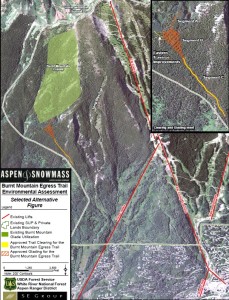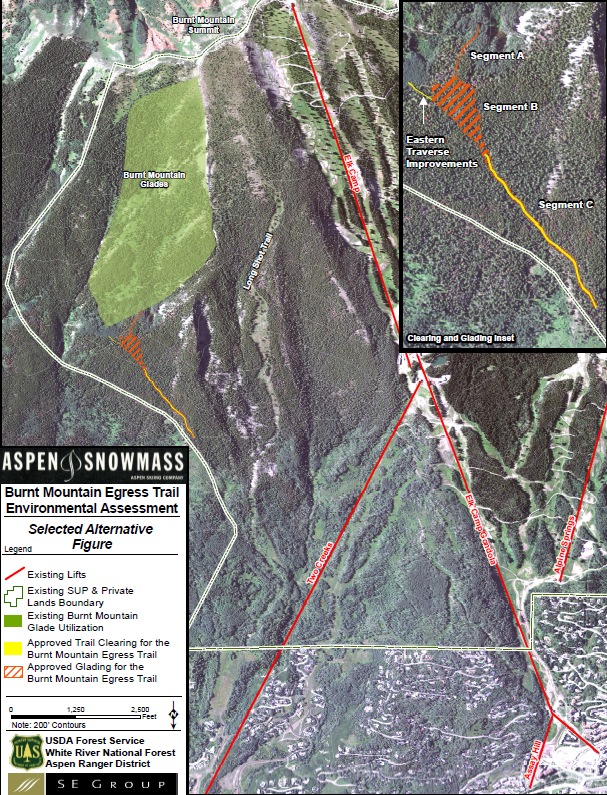Snowmass, CO – It wasn’t what Snowmass originally wanted, but it’s unlikely to satisfy environmentalists, either.
White River National Forest Supervisor Scott Fitzwilliams on Friday issued his agency’s decision on the egress route from Burnt Mountain, Snowmass’ 250 acres of new gladed ski and snowboard terrain first opened last winter. The decision seeks to strike a balance between Snowmass’ desire for a wide, comfortable route back from the glades to the resort’s lift and trail system, and the Ark Initiative’s plea to leave a roadless area intact.
Snowmass originally asked to cut a return route 3,200 feet long and 35 feet wide above what’s already known as the Eastern Traverse. Fitzwilliams’ decision, referenced in the project’s Environmental Assessment as Alternative 3, allows Snowmass to cut a 10 foot-wide route for the first 500 linear feet, where the route’s gentle six percent grade is unlikely to require skiers and riders to turn to check their speed. In the route’s steeper 30 percent section, Fitzwilliams is allowing glading of the terrain up to 250 feet wide for 700 linear feet. At the bottom of the gladed area, a 20-foot wide cleared egress trail will be created with 500 linear feet of spot grading to address side slope conditions that would better facilitate snowcat access for grooming. This grading would not be implemented during the initial construction of the project, as the decision calls for Snowmass and Forest Service officials to first monitor the effectiveness of the route without grading through one full winter.

In addition to this new egress route, Fitzwilliams’ decision allows for select tree removal along the initial section of the existing Eastern Traverse until it intersects the gladed skiing terrain. It would serve as a secondary route out of the Burnt Mountain Glades.
That’s nevertheless unlikely to satisfy the Ark Initiative, an environmental group based in Pinedale, Wyo., which has already filed three challenges to the Burnt Mountain expansion. Forest Service regulations allow for a 45-day appeal period after Fitzwilliams’ decision is published, and Aspen Skiing Co. can’t begin work until at least five days thereafter. That puts the calendar into mid-November, too late to initiate any of the work this season even if Fitzwilliams’ decision is left unchallenged.
“The argument of whether the Project Area should still be a designated roadless area has been challenged several times by individuals and organizations with a passionate interest in the area,” Friday’s decision acknowledges. “However, the Project Area is not a designated roadless area as defined by the Colorado Roadless Rule. I considered impacts to the full range of resources affecting the human, biological, and physical environments. I have reviewed the potential direct, indirect, and cumulative impacts. Specifically, I’ve considered the impacts to Canada lynx, scenery resources, soils and vegetation. Through the application of appropriate PDC (Project Design Criteria) identified to minimize impacts to these resources, I feel confident potential impacts have been thoroughly assessed and disclosed. Additionally, as a way to minimize impacts, I have approved an adaptive management technique to initially construct the project without grading portions of the egress trail,” Fitzwilliams concluded.

